Abstract
Takacs, Frank P. (McGill University, Montreal, Quebec, Canada), Tibor I. Matula, and Robert A. MacLeod. Nutrition and metabolism of marine bacteria. XIII. Intracellular concentrations of sodium and potassium ions in a marine pseudomonad. J. Bacteriol. 87:510–518. 1964.—Washed cells of a marine pseudomonad were suspended in buffered salt solutions containing, in addition to MgSO4, NaCl and KCl at various concentrations. The cells were centrifuged from the medium and analyzed for Na+ and K+. Inulin and C14-carboxypolyglucose were employed to estimate the volume of extracellular fluid associated with the packed cells. Intracellular Na+ and K+ concentrations were determined by correcting for the amount of Na+ and K+ in the extracellular fluid. At all levels of Na+ in the suspending medium (0 to 1 m), the intracellular and extracellular Na+ concentrations within the limits of experimental error were the same. The intracellular K+ concentrations were approximately double the extracellular concentrations at the two levels of K+ tested (0.01 and 0.15 m) and were not influenced by the amount of Na+ present. Intracellular and extracellular Cl− concentrations were the same at the one level of Cl− examined. The intracellular fluid volume varied with the NaCl or KCl concentration of the suspending medium, being greatest in the absence of added salts, decreasing to a minimum at 0.3 m salt, and then increasing slightly at higher salt concentrations. Most of the intracellular Na+ could be removed by washing with solutions of MgSO4 or sucrose, but a small amount [10 to 15 μmoles/g (dry weight)] remained bound to the cells.
Full text
PDF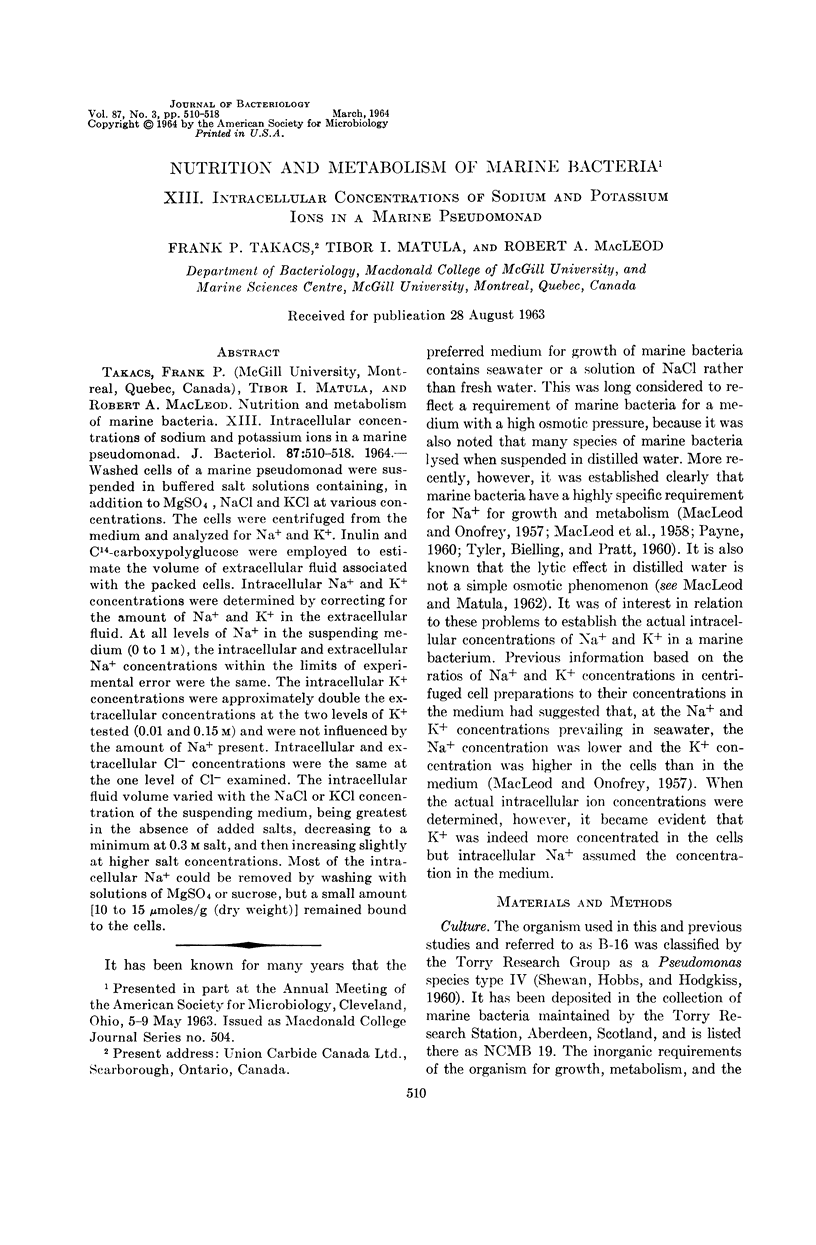
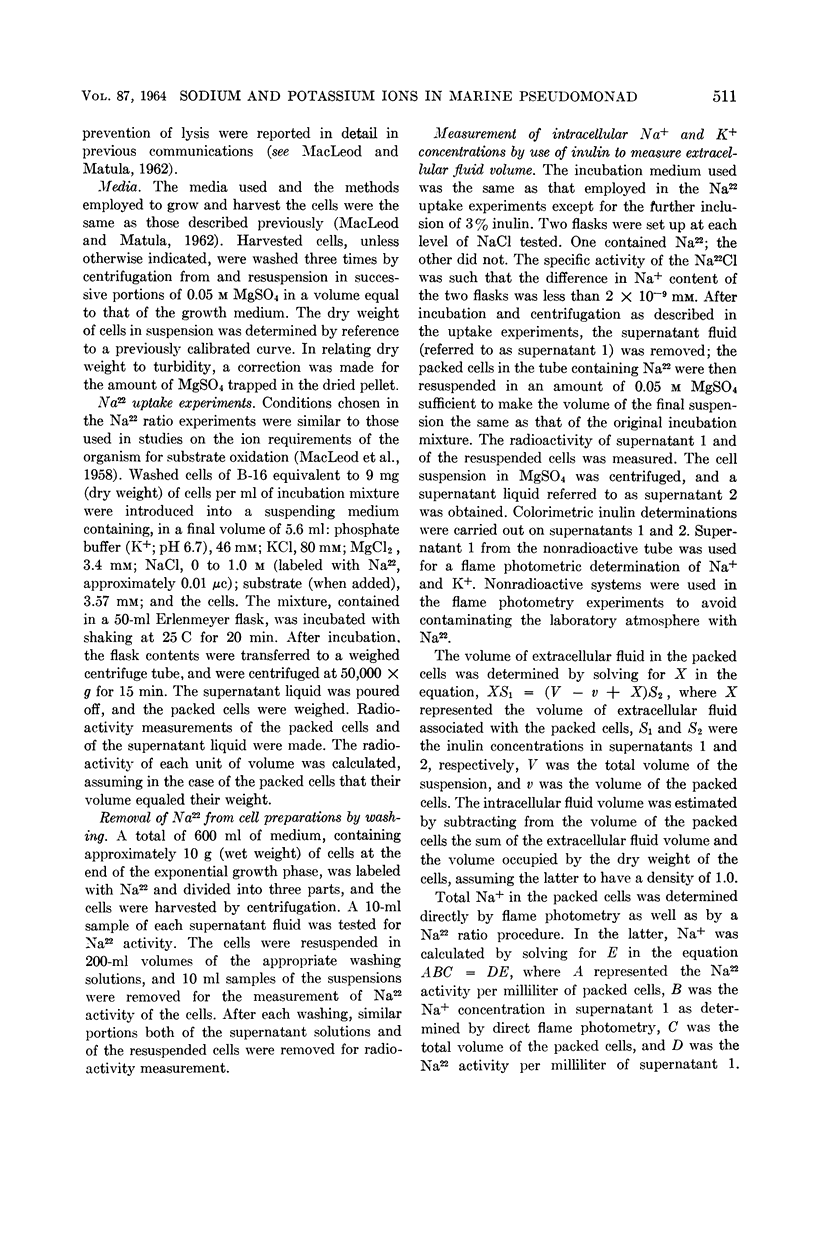
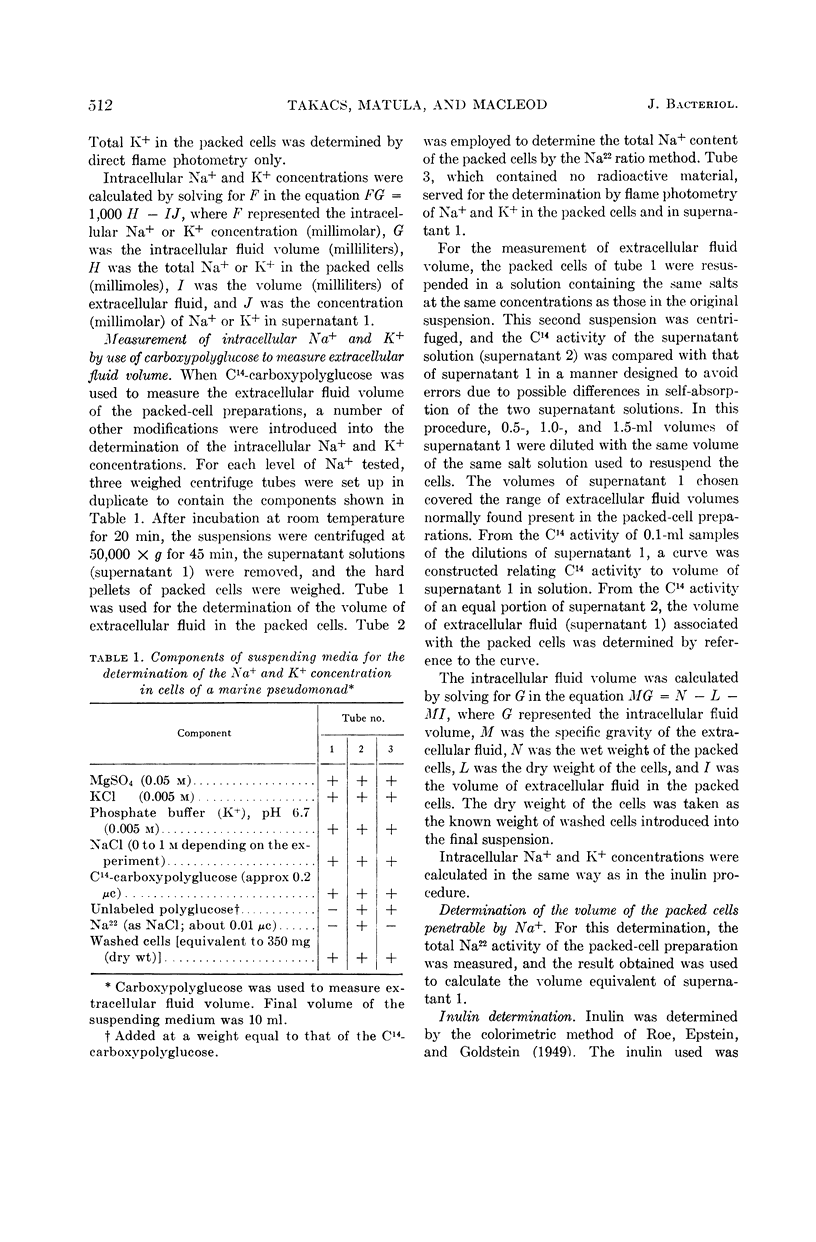
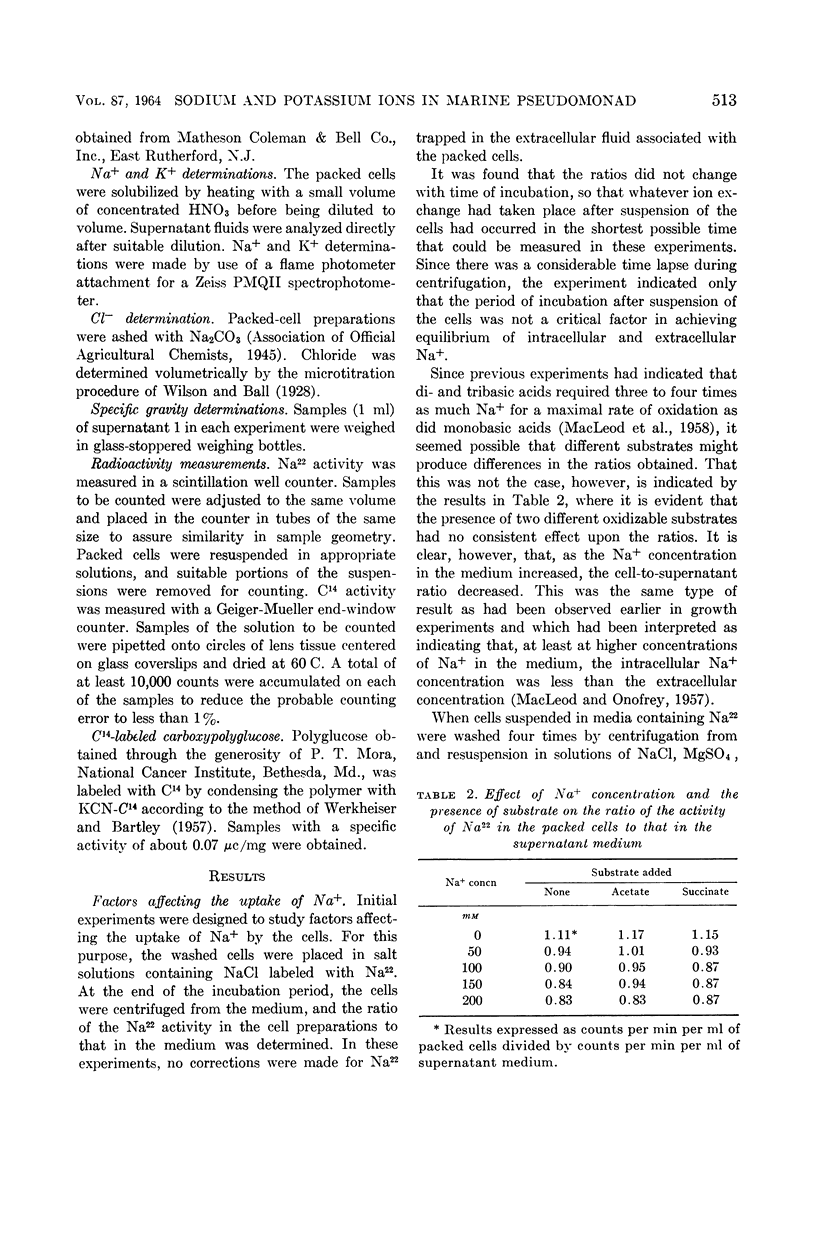
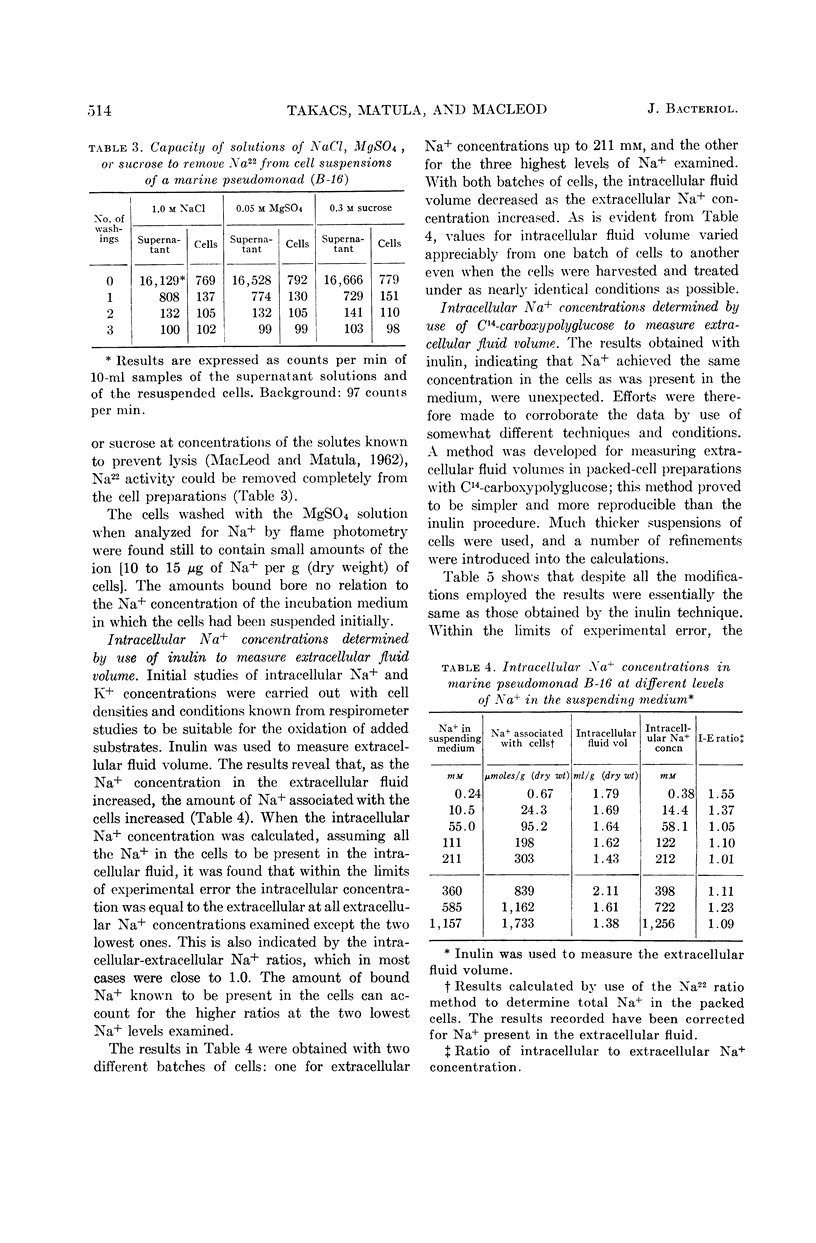


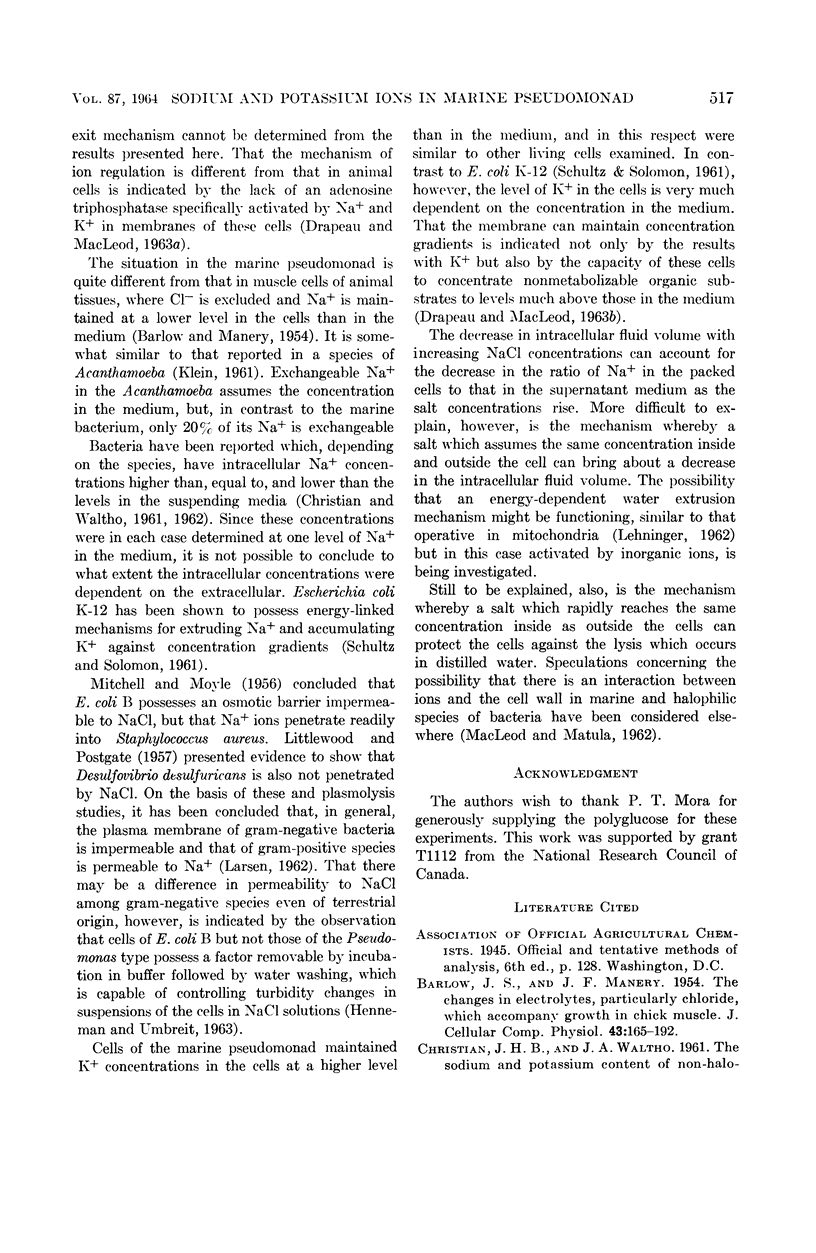

Selected References
These references are in PubMed. This may not be the complete list of references from this article.
- BARLOW J. S., MANERY J. F. The changes in electrolytes, particularly chloride, which accompany growth in chick muscle. J Cell Physiol. 1954 Apr;43(2):165–191. doi: 10.1002/jcp.1030430204. [DOI] [PubMed] [Google Scholar]
- CHRISTIAN J. H., WALTHO J. A. Solute concentrations within cells of halophilic and non-halophilic bacteria. Biochim Biophys Acta. 1962 Dec 17;65:506–508. doi: 10.1016/0006-3002(62)90453-5. [DOI] [PubMed] [Google Scholar]
- CHRISTIAN J. H., WALTHO J. A. The sodium and potassium content of non-halophilic bacteria in relation to salt tolerance. J Gen Microbiol. 1961 May;25:97–102. doi: 10.1099/00221287-25-1-97. [DOI] [PubMed] [Google Scholar]
- DRAPEAU G. R., MACLEOD R. A. NUTRITION AND METABOLISM OF MARINE BACTERIA. XII. ION ACTIVATION OF ADENOSINE TRIPHOSPHATASE IN MEMBRANES OF MARINE BACTERIAL CELLS. J Bacteriol. 1963 Jun;85:1413–1419. doi: 10.1128/jb.85.6.1413-1419.1963. [DOI] [PMC free article] [PubMed] [Google Scholar]
- KLEIN R. L. Homeostatic mechanisms for cation regulation in Acanthamoeba sp. Exp Cell Res. 1961 Dec;25:571–584. doi: 10.1016/0014-4827(61)90191-4. [DOI] [PubMed] [Google Scholar]
- LEHNINGER A. L. Water uptake and extrusion by mitochondria in relation to oxidative phosphorylation. Physiol Rev. 1962 Jul;42:467–517. doi: 10.1152/physrev.1962.42.3.467. [DOI] [PubMed] [Google Scholar]
- LITTLEWOOD D., POSTGATE J. R. On the osmotic behaviour of Desulphovibrio desulphuricans. J Gen Microbiol. 1957 Jun;16(3):596–603. doi: 10.1099/00221287-16-3-596. [DOI] [PubMed] [Google Scholar]
- MACLEOD R. A., CLARIDGE C. A., HORI A., MURRAY J. F. Observations on the function of sodium in the metabolism of a marine bacterium. J Biol Chem. 1958 Jun;232(2):829–834. [PubMed] [Google Scholar]
- MACLEOD R. A., ONOFREY E. Nutrition and metabolism of marine bacteria. III. The relation of sodium and potassium to growth. J Cell Physiol. 1957 Dec;50(3):389–401. doi: 10.1002/jcp.1030500305. [DOI] [PubMed] [Google Scholar]
- PAYNE W. J. Effects of sodium and potassium ions on growth and substrate penetration of a marine pseudomonad. J Bacteriol. 1960 Nov;80:696–700. doi: 10.1128/jb.80.5.696-700.1960. [DOI] [PMC free article] [PubMed] [Google Scholar]
- ROTHSTEIN A. Role of the cell membrane in the metabolism of inorganic electrolytes by microorganisms. Bacteriol Rev. 1959 Dec;23(4):175–201. doi: 10.1128/br.23.4.175-201.1959. [DOI] [PMC free article] [PubMed] [Google Scholar]
- SCHULTZ S. G., SOLOMON A. K. Cation transport in Escherichia coli. I. Intracellular Na and K concentrations and net cation movement. J Gen Physiol. 1961 Nov;45:355–369. doi: 10.1085/jgp.45.2.355. [DOI] [PMC free article] [PubMed] [Google Scholar]
- TYLER M. E., BIELLING M. C., PRATT D. B. Mineral requirements and other characters of selected marine bacteria. J Gen Microbiol. 1960 Aug;23:153–161. doi: 10.1099/00221287-23-1-153. [DOI] [PubMed] [Google Scholar]
- WERKHEISER W. C., BARTLEY W. The study of steady-state concentrations of internal solutes of mitochondria by rapid centrifugal transfer to a fixation medium. Biochem J. 1957 May;66(1):79–91. doi: 10.1042/bj0660079. [DOI] [PMC free article] [PubMed] [Google Scholar]


